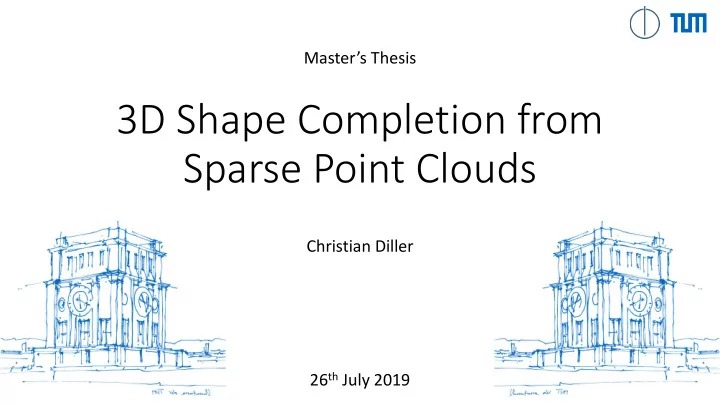

Master’s Thesis 3D Shape Completion from Sparse Point Clouds Christian Diller 26 th July 2019
Motivation 2
Motivation LiDAR Scanning • Sensing the environment • Sparse point measurements • Only partially visible objects 3
Motivation Laser Scanning • Precise point locations • Scanline approach • Requires controlled environment 4
Motivation Problem Statement Sparse and Partial Point Clouds 3D Shape Completion Dense Surface Meshes 5
3D Shape Completion from Sparse Point Clouds • Background • Data Generation • Network Architecture • Evaluation Results 6
Background 7
Background Regular Voxel Grids 3D Representations Polygonal Point Clouds Meshes 3D Shape Completion 8
Background 3D Shape Completion Direct Data-Driven Optimization Database Symmetry Completion Method Input Method 3D CNN on Voxels 3D CNN on Points Directly on Points Variational Autoencoder Autoregression GAN Autoencoder 9
Background PointNet • Classification and Segmentation • Operating directly on unstructured point clouds • Uses symmetric max pooling operation 10 32.C. R. Qi, H. Su, K. Mo, and L. J. Guibas. “PointNet - Deep Learning on Point Sets for 3D Classification and Segmentation.” In: CVPR (2017), pp. 77–85.
Background PointNet++ • Improvements by stacking multiple PointNets • Captures local point neighborhoods 11 49.C. R. Qi, L. Yi, H. Su, and L. J. Guibas. “PointNet++ - Deep Hierarchical Feature Learning on Point Sets in a Metric Space.” In: NIPS (2017).
Background 3D Encoder Predictor CNN • Learns shape completion with autoencoder-like architecture • Operates on regular voxel grids 12 A. Dai, C. R. Qi, and M. Nießner. “Shape Completion Using 3D-Encoder-Predictor CNNs and Shape Synthesis.” In: CVPR (2017), pp. 6545–6554.
Method Overview Method Overview Input: Output: • Sparse and Partial Point • Dense Surface Meshes Clouds • Vertices and faces • Unstructured list of xyz • Unsigned Distance Field as coordinates in 3D space intermediary representation 13
Data Generation 14
Data Generation ModelNet40 • High-Quality 3D CAD models • 40 object classes • 9843 train and 2468 test models 15 66.Z. Wu, S. Song, A. Khosla, F. Yu, L. Zhang, X. Tang, and J. Xiao. “3D ShapeNets - A deep representation for volumetric shapes.” In: CVPR (2015), pp. 1912–1920.
Data Generation Trajectory Sampling 1. Normalization to unit cube 2. Trajectory sampling with jitter 3. Virtual rendering from generated cameras Augmentations: 6 trajectories and up to 6 rotations per object 16
Data Generation Virtual Rendering 1. Virtual rendering from each camera 2. Backprojecting into common 3D space 3. Subsampling to get exactly 2048 points 17
Data Generation Data Formats • Input Data • Partial Point Clouds: 2048 points • Signed Distance Fields: 32 3 voxels • Target Data • Unsigned Distance Fields: 32 3 voxels • Complete Point Cloud: 4096 points 2D slice through a distance field volume 18
Network Architecture 19
Network Architecture Distance Field Generation • Ingesting 3D point cloud with 1D convolutional layers • Symmetric Max Pooling layer • Fully Connected layers on latent vector • Reshape and 3D Transpose Convolutions for volume generation 20
Network Architecture Loss on Distance Fields • l 2 Loss: Lacking Robustness 𝑒 " / (𝑦, 𝑧) = 1 (𝑦 - − 𝑧 - ) 0 𝑜 , - • l 1 Loss: Lacking Stability 𝑒 " # (𝑦, 𝑧) = 1 𝑜 , 𝑦 - − 𝑧 - - • Huber (smooth l 1 ) Loss 1 𝑒 12345 𝑦, 𝑧 = 1 2 (𝑦 - − 𝑧 - ) 0 , 𝑦 - − 𝑧 - < 1 𝑜 , 𝑨 - , with 𝑨 - = ; 𝑦 - − 𝑧 - , otherwise - 21
Network Architecture Loss on Distance Fields • Voxels far away contribute less to shape but influence loss more • Truncation removes high-value voxels from volume • Additional log scaling emphasizes changes in surface-near voxels 22
Results Evaluation: Loss on Distance Fields Truncation and Truncation and l 1 loss Rotations l 1 loss Log Scaling Log Scaling 1 No 0.016105 Yes 0.000881 3 No 0.016066 Yes 0.000996 6 No 0.016103 Yes 0.001123 Evaluating how truncation and logarithmic scaling impacts the resulting l 1 distance 23
Network Architecture Design Studies • Point Cloud Generation 24
Results Evaluation: Point Cloud Generation Rotations Accuracy Completeness 1 82.2% 79.2% 3 87.2% 69.3% 6 87.8% 67.1% Comparing accuracy and completeness across different number of rotational augmentations during training Accuracy: Percentage of points with distance to their ground-truth correspondence above a threshold • Completeness: Percentage of points with distance to their prediction correspondence above a threshold • 25
Network Architecture Design Studies • Hybrid Decoder 26
Results Evaluation: Hybrid Decoder Comparing the impact of using both distance field and point cloud decoders vs. only one of them 27
Network Architecture Design Studies • Classification Pseudo-Loss 28
Results Evaluation: Classification Classification Classification l 1 loss Decoder l 1 loss Branch Branch Distance Field No 0.000881 Yes 0.001272 Point Cloud No 82.2% / 79.2% Yes 75.8% / 65.1% Evaluating how adding a classification branch impacts prediction performance 29
Design Studies Design Studies • Encoders • PointNet • PointNet++ • 3D-EPN 30
Results Evaluation: Encoders l 1 loss l 1 loss l 1 loss Encoder (1 rotation) (3 rotations) (6 rotations) PointNet 0.001145 0.000854 0.001212 PointNet++ 0.001126 - - Point Cloud 0.000881 0.000996 0.001123 3D-EPN 0.00967 0.000907 0.001150 Comparing the impact of using different encoders on completion performance 31
Results 32
Results Evaluation: Overall 33
Results Qualitative: Mesh cup airplane bed guitar 34
Results Qualitative: Mesh lamp bottle bowl sofa 35
Results Qualitative: Point Cloud chair vase cone airplane 36
Results Limitations Missing geometry for fine structures 37
Results Limitations Fused geometry for fine structures 38
Results Limitations Missing geometry for areas with little information 39
Conclusion • Taking sparse and partial point clouds as input • Data-driven shape completion using an autoencoder-like architecture • Outputting dense surface mesh 40
3D Shape Completion from Sparse Point Clouds Thank you 41
Recommend
More recommend